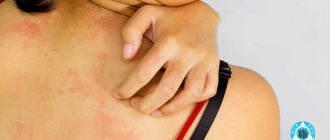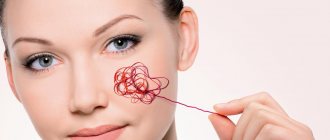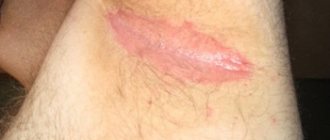Pregnancy is a period of enormous restructuring of the body, associated not only with the pleasant anticipation of the baby’s arrival, but also with significant discomfort. In addition to an enlarged belly, expectant mothers face a lot of changes, one of which is age spots (melasma, chloasma) on the face and body. Appearing during pregnancy, they are distinguished by a wide area of localization and a pronounced shade.
Do age spots always appear during pregnancy?
Almost every woman is faced with the issue of the appearance of age spots, because the process is associated with the restructuring of hormones that occurs during pregnancy. The body produces large amounts of melanin, which is concentrated in certain places.
Providing the synthesis of more estrogens and progesterone, more melanin is formed. The process has begun and pregnant women just need to know what is happening to their body.
Pigment spots do not have any effect on the baby, unless they are caused by an exacerbation of chronic ailments.
The degree of saturation with pigment spots increases as pregnancy progresses, but this is not necessary, and some women do not even encounter such a problem.
Review of real reviews
Apparently, many girls with prolonged pigmentation after childbirth only needed to push the melanin-colored cells to break down - when they started using White Flax peeling or clay masks, the spots went away. In this case, spots were not a problem, and creams with fruit acids helped to maintain good skin condition.
But those who got rid of pigmentation on the face after childbirth with the help of medical means - chemical peeling, mesotherapy, laser cleaning, note that cosmetics did not help them get rid of the disease, and to keep their face in order they use professional dermatological rulers.
Where are spots most likely to appear during pregnancy?
The color of the spots depends on skin type and hair color. They can appear on the face, inner thigh, stomach, arms, and chest. Pigmentation that appears on the face is often called chloasis or “mask of pregnancy.” It can take on different shapes, for example, appearing in the form of a spotted arc on the forehead. A woman may encounter an abundance of freckles, although it is cold outside and this is not their season at all. They do not cause discomfort and are yellowish to dark brown in color.
Breasts and nipples
The darkening of these areas makes many women think about pregnancy. It is the breasts and nipples that become stained first, which occurs in the first trimester. The shade of the nipples changes from pink to brown.
Legs and arms
The presence of freckles on the arms and legs becomes more noticeable and striking in the third trimester of pregnancy.
Back
Melanin in the skin is distributed unevenly, so the effects may appear in different areas. Most often, freckles appear on the back, which a woman could get under the scorching sun.
Stomach
On the abdomen, pigmentation is most often represented by a stripe from the navel to the pubis. In some it is more pronounced, in others it is visible, but it is still there. The reason for this is excessive production of melanin. A popular belief says that if the stripe is dark and runs across the entire belly, then future parents should expect a boy.
Dark stripe on the stomach
Every woman has an Alba line; it is located between the rectus muscles and stretches along the abdomen. Takes on a brown coloration only during pregnancy. This happens by the third trimester, but since everything is individual, earlier manifestations also occur.
Localization and general clinical picture
The most common locations for pigment spots during pregnancy are a woman's face and neck. The area around the eyes, the frontal part of the face, cheekbones and chin, and the bridge of the nose are the “favorite” places where spots appear in most expectant mothers. In addition, the thigh area (inner part), nipples on the mammary glands and the halo around them (peripapillary circles), and the skin on the abdomen are susceptible to pigmentation.
Pigmentation does not appear immediately. This is a gradual process. Darkening appears on the abdomen by the 28th week of pregnancy. Moreover, the pigmentation looks like a strip connecting the navel and pubic area. In medicine, this pregnancy stripe is called the Alba stripe, and this pigmentation is distinguished by the fact that it disappears longer than all other spots after childbirth.
Pigmentation remains on the chest (mammary glands) for the entire period of breastfeeding.
Face area – here, as a rule, the so-called “pregnant woman’s mask” is formed. It looks like pigment darkening along the line of the frontal part, from temple to temple, with a transition to the back of the nose, cheeks on both sides.
If a woman has a freckled face throughout her life, then these freckles will simply be brighter and clearer for the entire period of bearing the baby.
Pigmentation also occurs in the perineum, labia, armpits and neck.
Why do age spots appear during pregnancy?
- Hormonal changes in the body are inevitable during normal pregnancy. Its consequence may be the appearance of spots.
- Heredity can cause the appearance of spots, because genetically the process can be transmitted from mother or even grandmother.
- Stressful situations in which the expectant mother may find herself can also influence this process.
- Deficiency of folic acid in the body.
- Liver pathology (rare).
- Lack of vitamins B, C, copper, zinc, glands in the body, which must be balanced with the help of nutrition or special vitamin complexes that can only be prescribed by a specialist.
- Taking oral contraceptives before pregnancy.
- Long and systematic exposure to the sun.
- Poor provision of cosmetic services, use of poor cosmetics.
Given the existing factors, some of them can be prevented. For example, after consulting with your doctor, get a prescription and take folic acid.
When do they take place?
All changes in a woman’s body are temporary. Pigment spots also do not last long. Everything happens in a clear order - the weight returns to normal, hormone levels stabilize, and at the end of all processes, pigment spots disappear. Try to accept them as part of pregnancy and don't worry about trifles. The only cause for concern can be their persistence after childbirth; on average, they go away in 3-4 months. If they do not go away on their own, then you will have to resort to medical procedures or make various masks at home.
Home Recipes
It is also possible to remove postpartum pigmentation on the face at home with an integrated approach and a not very severe stage of the disease.
Since you can use essential oils after pregnancy, arm yourself with orange, lemon or some other citrus oil, jojoba or almond oil and clay. Clay can be taken in any color, but black, white and green are the most effective. Take 2 tablespoons of clay, add water to it until it becomes a thin cream, 5-7 drops of base oil, 3-4 drops of essential oil, mix thoroughly and apply to the face. Leave for 10-15 minutes; when it starts to dry out, sprinkle with thermal or regular water.
Using only aspirin tablets (2-3) and water, you can make your own acid peeling, mask or serum, which will be no less effective, but safer - the acid here is salicylic, which is not related to AHA acids.
Also don't forget about lemon juice, which can be mixed in a 1:2 ratio with water and used as a lotion at night.
You can get rid of age spots during pregnancy: tips
You can get rid of them or even minimize their manifestation if you remember simple rules:
- In summer, use sun protection, avoid direct rays, and wear a hat.
- The diet should contain vegetables and fruits with vitamin C and E, pay special attention to fermented milk products. Food should be easily digestible.
- Avoid strong drinks – coffee and tea.
- Even before conception, consume folic acid.
- In case of diseases of the liver, ovaries, or thyroid gland, the problem must be solved at the stage of pregnancy planning.
- Use quality cosmetics.
A healthy lifestyle and more walks in the fresh air will have a positive effect on the course of pregnancy. Women often solve the problem with folk remedies:
- Use kefir masks prepared with any fermented milk products;
- Masks and tinctures made from products that help whiten the skin - parsley, grapefruit juice, fresh cucumbers.
A beauty salon may offer laser therapy that eliminates pigmented areas. However, it is better to undergo this procedure after childbirth if the spots do not go away on their own. The specialist will tell you how suitable it is for your skin, and may recommend special creams that can solve the problem without laser intervention.
Pigmentation during pregnancy is a natural process that you should not be afraid of. It is important to monitor the body, which will prevent the problem. For example, if the reason is a lack of vitamins, then it is recommended to consult a doctor who will prescribe the appropriate medications. With the birth of the baby, the processes occurring in the body of the expectant mother are normalized, the hormonal levels will return to normal and the spots will go away on their own. Even if this did not happen so quickly, cosmetology has developed many modern means to solve this problem.
Pharmacy drugs
Treatment of pigmentation on the face during pregnancy or after childbirth is often carried out with medical products that can be purchased at the pharmacy. An integrated approach includes pharmaceutical preparations for cosmetic purposes, as well as tablets that can only be prescribed by a doctor.
Ampoules for mesotherapy are very popular. Since the classic version of this procedure involves inserting the drug, it is not recommended to do this at home - it is better to consult a cosmetologist. At home, you can buy a mesotherapy kit with a specialized massager and pamper yourself with a massage with a complex of active substances.
In the same way, you can buy serums with vitamin C, hyaluronic acid and collagen at the pharmacy and use them at night to avoid exposure to the active sun, and during the day use a cream with SPF of at least 30.
In pharmacies you can find whitening products labeled “Anti-pigmentation”, for example, creams, peels and clay masks called “White Linen” or “Achromin”.
The Russian line includes vitamin C, cucumber, green tea and flax extract and a small amount of fruit acids that can be used after the birth of a child - their concentration is so low. The line includes night and day cream, mousse, cream cocktail, tonic, clay masks (deep action with orange and bearberry extracts and a plasticizer mask with parsley), peeling, serum, local bleach and even a separate hand cream.
Attention! Despite the low content of fruit acids, sunbathing while using White Flax or going outside with it is not recommended for safety reasons. Based on this, you can safely cross the line’s day cream off your shopping list – you shouldn’t use it during the day anyway.
“Achromin” was known to our mothers for its whitening and at the same time protective effect. In addition, it moisturizes well, but is not suitable for those with oily skin - it is too thick and will clog pores.
Another popular remedy that reduces melanin production is the pharmaceutical Ayurvedic cream Clearvin. Since it does not contain acid and vitamin C, it can be used even during the day, even in summer with active sun. The whitening effect is achieved through a combination of plant, herbal and flower extracts. It also helps to resolve age spots and accelerate regeneration; it is used after operations, as it helps remove stitches and scars.
Also pay attention to the following:
- “Ideal Whitening” from Belita Vitex (tonic peeling and serum-corrector with acids);
- “Medoveya” from Natural Honey Product (cream with royal jelly and acids);
- Leniment balsamic ointment according to Vishnevsky (with birch tar);
- "Aevit" in the form of oil solutions or capsules (orally and a little on the skin at the same time).
What to do if stains don't go away
If your skin's genetic biology predisposes you to be highly pigmented, it will be difficult to do anything about it after dyeing it dark. Spots that cover the body for more than 1 year may indicate the development of pathology. In this case, you need to seek help from a dermatologist and undergo a diagnostic examination.
The most likely causes of prolonged pigmentation after childbirth:
- Gastrointestinal pathologies. The defect persists in the forehead area;
- Problems with the thyroid gland. Melasma stays around the eyes;
- Hormonal disbalance. Pigmentation covers the nose and cheeks, localized above the upper lip and on the chin.
Is it possible to somehow influence pigmentation?
Any changes in skin color due to melasma usually go away on their own after childbirth, but there are a few things you can do to prevent worse darkening:
- Use sunscreen . This is very important because exposure to ultraviolet (UV) rays causes melasma and worsens existing pigmentary changes. Use a broad-spectrum sunscreen (a formula that protects against both UVA and UVB rays) with SPF 30 or higher every day, even when it's not sunny. And reapply it often throughout the day if you're outside.
Even if you don't plan to leave the house or spend much time outside, it's a good idea to use sunscreen as part of your morning routine. 1 The Skin Cancer Foundation warns that your skin is exposed to significant amounts of ultraviolet radiation when you walk down the street, drive in a car or even sit indoors near a window.
Wear a wide-brimmed hat when outdoors, as well as long sleeves if you have pigmentation changes on your arms. Limit your time in the sun, especially from 10:00 to 14:00. And be sure to avoid tanning beds.
- Don't wax . Using wax to remove hair can cause inflammation of the skin, which can worsen melasma.
- Use hypoallergenic skin care products . Be critical of their choice: use only proven cosmetics containing natural ingredients.
- Apply concealer . If dark spots bother you, hide them by using makeup with white and yellow undertones. But do not use skin whitening products during pregnancy.
Melasma – will it stay after pregnancy or will it disappear?
Hyperpigmentation may go away without treatment after the baby is born. Usually within a year after giving birth, the skin clears up and returns to its normal shade, although it also happens that the darkening does not disappear completely.
For some women, birth control products that contain estrogen (such as the pill, patch, and vaginal ring) may also contribute to the development of melasma. If this happens and bothers you, consider another contraceptive option.
If your skin is still blotchy a few months after giving birth and you're concerned about it, talk to your doctor or dermatologist about treatment options for melasma. He may suggest using a whitening cream containing hydroquinone (and possibly sunscreen), a topical product containing tretinoin (Retin-A), or a chemical peel such as glycolic acid.
If you are breastfeeding or plan to become pregnant again soon, tell and consult your doctor before taking any over-the-counter medications.
Don't expect instant results - improvement may take months. If other treatments don't work, a beauty clinic can lighten dark spots with laser therapy, but that's the next step.
Either way, continue to protect your skin from the sun by wearing sunscreen every day, wearing protective clothing, and staying out of the sun during its active phases.
Useful video about pigmentation after childbirth
List of sources:
- Kruglova L. S., Ikonnikova E. V. Skin hyperpigmentation: modern views on etiology and pathogenesis // Scientific article on the specialty “Fundamental Medicine. Russian Journal of Skin and Venereal Diseases. 2017; 20(3): 178-183 p.
- Olisova O. Yu. Andreeva E. V. Once again about the problem of hyperpigmentation // Scientific article in the specialty “Clinical Medicine”. Russian Journal of Skin and Venereal Diseases. 2017; 20(4): 248-251 p.
Author
Elena Medvedeva
Specialist
Graduated from the Ural State Medical Academy of Yekaterinburg with a degree in General Medicine. Work experience: intensive care team, physician at an enterprise.
Share










